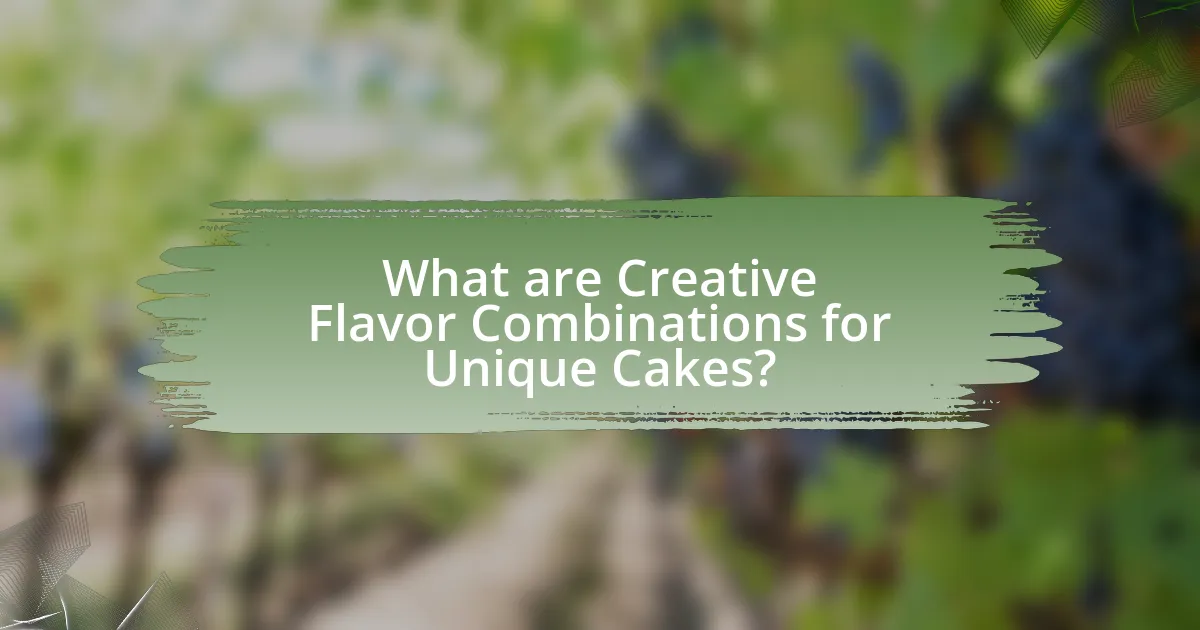The article focuses on creative flavor combinations for unique cakes, highlighting pairings such as lavender and honey, chocolate and chili, and lemon and basil. It explores how these combinations enhance the cake experience by creating complex taste profiles that engage the senses and evoke emotional responses. Additionally, the article discusses the impact of flavor pairings on cake texture and moisture, the importance of creativity in flavor development, and the influence of cultural elements on innovative baking. It also provides insights into popular and unconventional flavor combinations, best practices for pairing flavors, and tips for successful experimentation in cake creation.

What are Creative Flavor Combinations for Unique Cakes?
Creative flavor combinations for unique cakes include lavender and honey, chocolate and chili, lemon and basil, and matcha and white chocolate. These pairings enhance the cake’s flavor profile, creating distinctive taste experiences. For instance, lavender and honey provide a floral sweetness, while chocolate and chili introduce a spicy kick, appealing to diverse palates. Lemon and basil offer a refreshing contrast, and matcha with white chocolate combines earthy and creamy notes, making these combinations popular in contemporary baking.
How can flavor combinations enhance the cake experience?
Flavor combinations can enhance the cake experience by creating a more complex and enjoyable taste profile. When different flavors are paired, such as chocolate and orange or vanilla and almond, they can complement each other, leading to a richer sensory experience. Research indicates that flavor pairing can stimulate the palate and evoke emotional responses, making the cake more memorable. For instance, a study published in the journal “Food Quality and Preference” found that unique flavor combinations can increase consumer satisfaction and preference, demonstrating that innovative pairings can elevate the overall enjoyment of cake.
What are the sensory effects of different flavor pairings?
Different flavor pairings can significantly enhance sensory experiences by creating complex taste profiles that engage multiple senses. For example, the combination of chocolate and chili not only provides a rich sweetness but also introduces a spicy heat that activates taste receptors differently, resulting in a more dynamic flavor experience. Research indicates that contrasting flavors, such as sweet and salty, can stimulate the brain’s reward system, leading to increased enjoyment and satisfaction. A study published in the journal “Food Quality and Preference” by A. A. de Araujo et al. found that flavor pairings that balance sweetness with acidity, like lemon and sugar, can enhance perceived freshness and overall palatability. These sensory effects illustrate how thoughtful flavor combinations can elevate culinary creations, particularly in unique cake recipes.
How do flavor combinations influence cake texture and moisture?
Flavor combinations significantly influence cake texture and moisture by altering the chemical interactions during baking. For instance, the inclusion of acidic ingredients like citrus or yogurt can enhance moisture retention due to their ability to break down gluten, resulting in a tender crumb. Additionally, pairing flavors such as chocolate with coffee can create a denser texture, as the richness of chocolate complements the moisture content provided by the coffee. Studies show that cakes with balanced flavor profiles, which include both sweet and acidic notes, tend to have improved moisture levels and a more appealing texture, as the acidity can enhance the overall flavor perception while maintaining a soft structure.
Why is creativity important in cake flavor combinations?
Creativity is important in cake flavor combinations because it enhances the sensory experience and distinguishes products in a competitive market. Unique flavor pairings can evoke emotions and memories, making cakes more memorable for consumers. For instance, combining unexpected flavors like lavender and lemon can create a refreshing taste that stands out, appealing to adventurous eaters. Research indicates that innovative flavor combinations can increase consumer interest and sales, as seen in the rise of gourmet bakeries that thrive on unique offerings.
How does creativity impact customer preferences?
Creativity significantly influences customer preferences by enhancing the appeal and uniqueness of products, such as cakes. When cake makers introduce innovative flavor combinations, they capture customer interest and differentiate themselves in a competitive market. Research indicates that 70% of consumers are more likely to try a product that features unique flavors, as highlighted in a study by the Institute of Culinary Education. This demonstrates that creative offerings not only attract attention but also drive purchasing decisions, ultimately shaping customer preferences toward more adventurous and novel choices in cake flavors.
What role does cultural influence play in flavor creativity?
Cultural influence plays a significant role in flavor creativity by shaping the ingredients, techniques, and flavor profiles that are utilized in culinary practices. Different cultures have distinct culinary traditions that dictate the use of specific spices, fruits, and preparation methods, which in turn inspire innovative flavor combinations. For instance, the fusion of Asian and Western flavors has led to unique desserts like matcha-infused cakes or mango sticky rice cake, showcasing how cultural elements can enhance creativity in flavor development. This blending of cultural influences not only broadens the palate but also encourages chefs to experiment with unconventional pairings, ultimately leading to the creation of unique cakes that reflect diverse culinary heritages.

What are some popular flavor combinations for unique cakes?
Popular flavor combinations for unique cakes include chocolate and raspberry, lemon and lavender, and vanilla and chai. Chocolate and raspberry create a rich and tart balance, appealing to those who enjoy contrasting flavors. Lemon and lavender offer a refreshing and aromatic experience, often favored in spring and summer desserts. Vanilla and chai combine the classic sweetness of vanilla with the warm spices of chai, resulting in a comforting and exotic taste. These combinations are frequently used in gourmet baking and have gained popularity in various culinary circles, showcasing their versatility and appeal.
What are classic flavor pairings that work well together?
Classic flavor pairings that work well together include chocolate and raspberry, vanilla and almond, lemon and blueberry, and caramel and sea salt. These combinations are widely recognized for their complementary tastes, enhancing the overall flavor profile of desserts. For instance, chocolate and raspberry create a rich and tart contrast, while vanilla and almond provide a warm, nutty sweetness. Lemon and blueberry offer a refreshing balance of acidity and sweetness, and caramel with sea salt adds depth through the interplay of sweet and savory elements. These pairings are often used in baking and pastry to create harmonious and appealing desserts.
How do chocolate and fruit flavors complement each other?
Chocolate and fruit flavors complement each other through a balance of richness and acidity. The sweetness and creaminess of chocolate enhance the tartness and freshness of fruits, creating a harmonious taste experience. For example, dark chocolate’s bitterness pairs well with the natural sugars in berries, while citrus fruits like orange or lemon can brighten the deep flavors of chocolate. This combination is supported by culinary practices that highlight how contrasting flavors can elevate desserts, making them more complex and enjoyable.
What makes vanilla and spice combinations appealing?
Vanilla and spice combinations are appealing due to their ability to create a harmonious balance of sweetness and warmth. The natural sweetness of vanilla enhances the complex flavors of spices like cinnamon, nutmeg, and clove, resulting in a rich and inviting taste profile. Research indicates that the combination of vanilla and spices can evoke feelings of comfort and nostalgia, making them popular in baked goods. For instance, a study published in the Journal of Food Science found that vanilla enhances the perception of sweetness, allowing spices to shine without overwhelming the palate. This synergy not only elevates the flavor experience but also contributes to the overall sensory enjoyment of cakes and desserts.
What are some unconventional flavor combinations to try?
Some unconventional flavor combinations to try include lavender and lemon, chocolate and chili, and basil and strawberry. Lavender and lemon create a refreshing yet aromatic profile, often used in desserts to enhance the citrus flavor. Chocolate and chili add a spicy kick to the rich sweetness of chocolate, creating depth and complexity in cakes. Basil and strawberry offer a unique blend of herbaceous and fruity notes, making for a surprising yet delightful pairing in desserts. These combinations are increasingly popular in gourmet baking, showcasing how unexpected flavors can elevate traditional cake recipes.
How can savory ingredients enhance sweet cakes?
Savory ingredients can enhance sweet cakes by adding depth and complexity to their flavor profiles. For instance, incorporating ingredients like sea salt, herbs, or spices can create a balance between sweetness and savory notes, making the cake more intriguing. Research indicates that the contrast between sweet and savory flavors can stimulate the palate, leading to a more enjoyable eating experience. A study published in the “Journal of Culinary Science & Technology” highlights how the addition of herbs like rosemary or thyme can elevate the overall flavor of desserts, demonstrating that savory elements can complement and enhance sweetness effectively.
What unique flavor profiles can be created with herbs and spices?
Unique flavor profiles created with herbs and spices include combinations such as basil and lemon, which provide a fresh and zesty taste, and rosemary with chocolate, offering an earthy depth. Additionally, pairing cardamom with vanilla creates a warm, aromatic sweetness, while thyme and orange zest introduce a bright, herbal note. These combinations enhance the overall flavor complexity in cakes, making them stand out. For instance, the use of lavender in desserts has been documented to evoke a floral essence, which can elevate a cake’s profile significantly.

How can I create my own unique cake flavor combinations?
To create your own unique cake flavor combinations, start by experimenting with various base flavors, such as vanilla, chocolate, or lemon, and then incorporate complementary ingredients like fruits, spices, or extracts. For instance, pairing chocolate with orange zest or vanilla with lavender can yield distinctive results. Additionally, consider regional or seasonal ingredients to inspire creativity; for example, using pumpkin in the fall or tropical fruits in summer can enhance flavor profiles. Research shows that flavor pairing can be guided by the concept of flavor compounds, where ingredients sharing similar compounds often taste good together, as noted in the book “The Flavor Bible” by Karen Page and Andrew Dornenburg.
What steps should I follow to experiment with flavors?
To experiment with flavors, start by selecting a base flavor for your cake, such as vanilla or chocolate. Next, identify complementary flavors that enhance the base, like pairing vanilla with almond or chocolate with orange. Then, create small test batches to combine these flavors in different ratios, allowing you to assess their balance and harmony. Document each combination and your tasting notes to track which pairings work best. Finally, refine your recipes based on feedback and personal preference, ensuring that the final flavor profile is unique and enjoyable.
How do I balance sweetness and acidity in flavor combinations?
To balance sweetness and acidity in flavor combinations, use complementary ingredients that enhance each other. For example, pairing sweet fruits like strawberries with acidic elements such as lemon juice creates a harmonious flavor profile. This balance can be achieved by adjusting the ratios of sweet and acidic components; for instance, adding a small amount of acidity can brighten the sweetness without overpowering it. Research indicates that the human palate perceives balanced flavors more favorably, as seen in culinary practices where chefs often combine sweet and sour elements to create depth in dishes.
What tools can help in flavor experimentation?
Tools that can help in flavor experimentation include flavor pairing software, sensory analysis kits, and ingredient databases. Flavor pairing software, such as FlavorPrint, analyzes chemical compounds in ingredients to suggest complementary flavors, enhancing creativity in cake design. Sensory analysis kits allow bakers to evaluate taste and aroma profiles systematically, ensuring balanced flavor combinations. Ingredient databases provide extensive information on flavor profiles and culinary uses, aiding in the selection of unique ingredients for innovative cake recipes. These tools collectively facilitate informed decision-making in flavor experimentation, leading to more successful and unique cake creations.
What tips can help ensure successful flavor combinations?
To ensure successful flavor combinations, focus on balancing complementary and contrasting flavors. For instance, pairing sweet elements like chocolate with salty components such as sea salt enhances the overall taste experience. Additionally, consider the intensity of flavors; strong flavors like dark chocolate can be balanced with lighter flavors like vanilla or citrus to create harmony. Research indicates that flavor pairing based on chemical compounds, such as the study by Ahn et al. (2011) in the Journal of Food Science, shows that certain flavors naturally enhance each other, providing a scientific basis for these combinations.
How can I use seasonal ingredients for unique flavors?
Using seasonal ingredients enhances unique flavors by incorporating fresh, locally available produce that reflects the time of year. For example, using ripe strawberries in spring or pumpkin in autumn can create distinct taste profiles that resonate with seasonal themes. Seasonal ingredients often have peak flavor and nutritional value, which can elevate the overall quality of cakes. Research indicates that seasonal produce can contain higher levels of vitamins and antioxidants, contributing to both taste and health benefits. Thus, utilizing seasonal ingredients not only diversifies flavor combinations but also supports local agriculture and sustainability.
What are common mistakes to avoid when creating new flavors?
Common mistakes to avoid when creating new flavors include neglecting balance, overlooking ingredient compatibility, and failing to consider consumer preferences. Neglecting balance can lead to overpowering flavors that clash rather than complement each other, which diminishes the overall taste experience. Overlooking ingredient compatibility may result in combinations that do not harmonize, leading to unappealing flavors. Additionally, failing to consider consumer preferences can alienate potential customers; for instance, using overly exotic ingredients may deter those who prefer familiar tastes. These mistakes can significantly impact the success of new flavor creations in the cake industry.
What are some best practices for pairing flavors in cakes?
Best practices for pairing flavors in cakes include balancing complementary and contrasting tastes, using seasonal ingredients, and considering texture. Complementary flavors, such as chocolate and coffee, enhance each other, while contrasting flavors, like citrus and rich butter, create a dynamic taste experience. Seasonal ingredients, such as fresh berries in summer or spices in fall, ensure freshness and relevance. Additionally, pairing textures, like a moist cake with a crunchy topping, adds depth to the overall flavor profile. These practices are supported by culinary principles that emphasize harmony and variety in flavor combinations.




